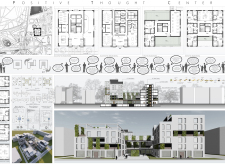5 key facts about this project
The center is characterized by its modular structure, which allows for various spatial configurations that adapt to changing community needs. The flexibility in design caters to different activities, including offices, therapy rooms, and community gathering spaces. This adaptability ensures that the Positive Thought Center can evolve alongside its users, making it a long-lasting fixture in the community.
Sustainability is central to the project. The choice of materials includes cross-laminated timber (CLT), which serves as the primary structural element. This renewable material not only contributes to the building's aesthetic appeal but also enhances its acoustic performance and energy efficiency. Large glass facades facilitate natural lighting and provide expansive views of the surrounding environment, establishing a strong connection between indoor and outdoor spaces.
The incorporation of green elements, such as vertical gardens and plant life on building surfaces, underscores the project's commitment to environmental stewardship. These features not only enhance the visual landscape but also improve air quality and promote biodiversity, adhering to principles of biophilic design.
The Positive Thought Center differentiates itself through its emphasis on community engagement. Open plazas and communal gardens are integral features that encourage social interaction. Unlike many projects that prioritize individual space, this center is designed to cultivate a sense of belonging among its occupants. The careful arrangement of communal areas promotes collaboration and supports various programs, enhancing the overall function of the building.
Another distinguishing factor is the project's focus on flexible use. The modular design allows different areas to be repurposed as community requirements change, ensuring the building remains relevant and functional over time. This approach addresses the dynamic nature of community needs while maximizing the utility of the space.
Overall, the Positive Thought Center exemplifies contemporary architecture committed to sustainability, adaptability, and engagement. Its innovative design communicates a clear vision for community-centric living, where both individual and collective well-being are prioritized. Those interested in deeper insights are encouraged to explore the architectural plans and sections of the project, as well as the architectural ideas that underpin its design.























